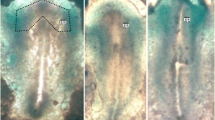Summary
Autoradiographic and histochemical techniques were used to determine whether chondrocytes continue to synthesize chondroitin sulfate or closely related compounds during morphological dedifferentiation of these cells in regenerating limbs of larvalAmbystoma. Forelimbs were amputated either through the mid-diaphysis or the distal epiphysis of the humerus and each animal was subsequently injected with Na2 35SO4 at an appropriate stage of regeneration. Incorporation of the isotope and metachromatic staining responses were used as indices of cell specialization.
In autoradiographs of unamputated limbs, epiphyseal chondrocytes exhibited moderate sulfate incorporation, whereas isotope uptake was slight in diaphyseal regions. Accordingly, in early stages of regeneration, limbs amputated through the diaphysis showed a low level of sulfate incorporation by cartilage-derived cells; since these cells dispersed during blastema formation, they were not identifiable in later stages. When limbs were amputated through the epiphysis, the matrix here underwent slow dissolution and epiphyseal-derived chondrocytes and their progeny consequently remained identifiable as they contributed to the blastema. These cells continued to exhibit isotope uptake, even during early and middle stages of regeneration —results which support the idea of tissue-specific regeneration of cartilage.
Further inspection of the stained autoradiographs revealed that in addition to chondrocytes and blastema cells derived from chondrocytes, fibroblast-like cells located lateral to the limb skeleton and seemingly derived from muscle or muscle-associated cells also exhibited a moderate label during certain stages in the restoration of the limb. In several respects isotope incorporation and related metachromatic responses by these two types of cells during blastemal and early redifferentiating stages of regeneration were seen to parallel results reported in the literature of histochemical and autoradiographic studies of differentiating chick fimb buds. These observations, which may be added to previous analogies concerning developing and regenerating limbs, suggest a similar mechanism of cytodifferentiation in the two systems. The possibility is also considered that the observed isotope uptake by cells of non-cartilaginous origin may indicate the synthesis of sulfated glycosaminoglycans which alfect cell interactions during the regenerative processes.
Similar content being viewed by others
References
Campo, R.D.: Protein-polysaccharides of cartilage and bone in health and disease. Clin. Orthop.68, 182–209 (1970)
Caplan, A.I., Koutroupas, S.: The control of muscle and cartilage development in the chick limb: the role of differential vascularization. J. Embryol. exp. Morph.29, 571–583 (1973)
Delbrück, A.: Enzyme activity determinations in bone and cartilage. Enzymol. Biol. and Clin.111, 130–153 (1970)
Eggert, R.C.: The response of x-irradiated limbs of adult urodeles to autographs of normal cartilage. J. exp. Zool.161, 369–390 (1966)
Faber, J.: Vertebrate limb ontogeny and limb regeneration: Morphogenetic parallels. Advanc. Morphogenes.9, 127–147 (1971)
Foret, J.E.: Regeneration of larval urodele limbs containing homoplastic transplants. J. exp. Zool.175, 297–322 (1970)
Herbai, G.: Autoradiographic studies with35S-sulfate on somatotrophin and estrogen sensitive growth zones in rat and mouse costal cartilagein vivo andin vitro. Acta physiol. scand.79, 351–358 (1970a)
Herbai, G.: Incorporation and disappearance of sulfate in different regions of mouse and rat costal cartilagein vivo andin vitro. Acta physiol. scand.79, 541–551 (1970b)
Humason, G.L.: Animal tissue techniques. San Francisco: W.H. Freeman. 1972
Kosher, R.A., Searls, R.L.: Sulfated mucopolysaccharide synthesis during the development ofRana pipiens. Develop. Biol.32, 50–68 (1973)
Manasek, F.J.: Sulfated extracellular matrix production in the embryonic heart and adjacent tissues. J. exp. Zool.174, 415–440 (1970)
Medoff, J.: Enzymatic events during cartilage differentiation in the chick embryonic limb bud. Develop. Biol.16, 118–143 (1967)
Patrick, J., Briggs, R.: Fate of cartilage cells in limb regeneration in the axolotl (Ambystoma mexicanum). Experientia (Basel)20, 431 (1964)
Saito, T.: Autoradiographic study on the35S-sulfate metabolism in the regenerating tissues of the adult newt forelimb. Embryologia (Nagoya)9, 279–286 (1967)
Saunders, J.W., Jr.: The proximo-distal sequence of origin of the parts of the chick wing and the role of the ectoderm. J. exp. Zool.108, 363–404 (1948)
Saunders, J.W., Jr., Cairns, J.M., Gasseling, M.: The role of the apical ridge of ectoderm in the differentiation of the morphological structure and inductive specificity of limb parts in the chick. J. Morph.101, 57–87 (1957)
Schacter, L.P.: Effect of conditioned media on differentiation in mass cultures of chick limb bud cells. I. Morphological effects. Exp. Cell Res.63, 20–32 (1970)
Schmidt, A., Weidman, T.: Dehydrogenases and aldolase in regenerating forelimbs of the adult newt,Diemictylus viridescens. J. exp. Zool.155, 303–316 (1964)
Searls, R.L.: An autoradiographic study of the uptake of35S-sulfate during the differentiation of limb cartilage. Develop. Biol.11, 155–168 (1965a)
Searls, R.L.: Isolation of mucopolysaccharide from the precartilaginous embryonic chick limb bud. Proc. Soc. exp. Biol. (N.Y.)118, 1172–1176 (1965b)
Searls, R.L.: The role of cell migration in the development of the embryonic chick limb bud. J. exp. Zool.166, 39–50 (1967)
Searls, R.L., Janners, M.Y.: The stabilization of cartilage properties in the cartilage-forming mesenchyme of the embryonic chick limb. J. exp. Zool.170, 365–376 (1969)
Steen, T.P.: Stability of chondrocyte differentiation and contribution of muscle to cartilage during limb regeneration in the axolotl (Siredon mexicanum). J. exp. Zool.167, 49–78 (1968)
Stocum, D.L., Dearlove, G.: Epidermal-mesodermal interaction during morphogenesis of the limb regeneration blastema in larval salamanders. J. exp. Zool.181, 49–61 (1972)
Thornton, C.S.: Histological modifications in denervated injured forelimbs ofAmblystoma larvae. J. exp. Zool.122, 119–150 (1953)
Trampusch, H.A.L., Harrebomée, A.E.: Dedifferentiation a prerequisite of regeneration. In: Regeneration in animals and related problems, ed. V. Kiortsis and H.A.L. Trampusch, p. 341–376. Amsterdam: North Holland Publ. Co. 1965
Zwilling, E.: Morphogenetic phases in development. Develop. Biol. Supp.2, 184–207 (1968)
Author information
Authors and Affiliations
Additional information
A portion of a dissertation submitted to the University of New Hampshire in partial fulfillment of the requirements for the degree of Doctor of Philosophy.
NASA Predoctoral Trainee during the course of this work.
The authors wish to thank Nr. Carl Paulitz for his assistance in photography of the autoradiographs.
Rights and permissions
About this article
Cite this article
Mattson, P., Foret, J.E. Autoradiographic analyses of35S-sulfate uptake in regenerating limbs of larvalAmbystoma . W. Roux' Archiv f. Entwicklungsmechanik 173, 169–182 (1973). https://doi.org/10.1007/BF00573113
Received:
Issue Date:
DOI: https://doi.org/10.1007/BF00573113




